F/A-18 Hornet
(Redirected from F-18)
| F/A-18 Hornet | |
|---|---|
| F/A-18 in flight | |
| Type | Multirole fighter |
| Manufacturer | McDonnell Douglas/Boeing Northrop |
| Designed by | McDonnell Douglas |
| Maiden flight | 18 November 1978 |
| Introduction | 7 January 1983 |
| Primary users | United States Navy United States Marine Corps Royal Australian Air Force Spanish Air Force |
| Number built | >1,458 |
| Unit cost | US$35 million in 2003 |
| Developed from | Northrop YF-17 |
| Variants | CF-18 Hornet F/A-18E/F Super Hornet EA-18 Growler |
The McDonnell Douglas (now Boeing) F/A-18 Hornet is a modern all-weather carrier-capable strike fighter jet, designed to attack both ground and aerial targets. Designed in the 1970s for service with the U.S. Navy and U.S. Marine Corps, the Hornet is also used by the air forces of several other nations. It has been the aerial demonstration aircraft for the Blue Angels since 1986. Its primary missions are fighter escort, fleet air defense, suppression of enemy air defenses (SEAD), interdiction, close air support and reconnaissance. Its versatility and reliability have proven it to be a valuable carrier asset, though it has been criticized for its lack of range and payload compared to its contemporaries.[1] The Hornet has also been exported to several nations worldwide.
The F/A-18E/F Super Hornet is a distinct, evolutionary upgrade to the F/A-18 designed to serve a complementary role with Hornets in the U.S. Navy.[2]
Contents[hide] |
[edit] Development
[edit] Origins
Development of the F/A-18 came as a result of the U.S. Navy's Naval Fighter-Attack, Experimental (VFAX) program to procure a multirole aircraft to replace the F-4 Phantom II, A-4 Skyhawk, and A-7 Corsair II, and to complement the F-14 Tomcat. Vice Admiral Kent Lee, then head of Naval Air Systems Command (NAVAIR), was the lead advocate for the VFAX against strong opposition from many Navy officers, including Vice Admiral William D. Houser, deputy chief of naval operations for air warfare - the highest ranking naval aviator.[3]

In August 1973, congress mandated that the Navy pursue a lower-cost alternative to the F-14. Grumman proposed a stripped F-14 designated the F-14X, while McDonnell Douglas proposed a navalized F-15, but both were nearly as expensive as the F-14.[4] That summer, Secretary of Defense Schlesinger ordered the Navy to evaluate the competitors in the Air Force's Lightweight Fighter (LWF) program, the General Dynamics YF-16 and Northrop YF-17.[5] Though the competition specified a day fighter with no strike capability. In May 1974, the House Armed Services Committee redirected $34 million from the VFAX to a new program, the Navy Air Combat Fighter (NACF),[5] intended to make maximum use of the technology developed for the LWF program.[4]
[edit] Redesigning the YF-17
Though the YF-16 won the LWF competition, the Navy was skeptical that an aircraft with one engine and narrow landing gear could be easily or economically adapted to carrier service, and refused to adopt an F-16 derivative. The Navy fought for and won permission to develop an aircraft based on the YF-17. Since the LWF did not share the design requirements of the VFAX, the Navy asked McDonnell Douglas and Northrop to design a new aircraft around the configuration and design principles of the YF-17. The new aircraft, designated the F-18, shared not a single essential dimension or primary structure with the YF-17. Secretary of the Navy W. Graham Claytor announced on 1 March 1977 that the name of the aircraft would be "Hornet".[6]
Northrop had enlisted the aid of McDonnell Douglas as a secondary contractor on the NACF proposal to capitalize on the latter's extensive experience in building carrier aircraft, including the highly successful F-4 Phantom II. On the F-18, the two companies agreed to split the parts manufacture evenly, with McDonnell Douglas completing the final assembly, representing ~20% of the work. McDonnell Douglas built the wings, stabilators, and forward fuselage; Northrop built the center and aft fuselage and vertical stabilizers. McDonnell Douglas was the prime contractor for the naval versions.[5] Northrop would become the prime contractor and take over final assembly for the F-18L land-based version which Northrop hoped to sell on the export market.
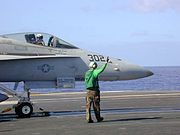
The F-18, initially known as McDonnell Douglas Model 267, was drastically modified from the YF-17 while retaining the same basic configuration. For carrier operations, the airframe, undercarriage, and arrestor hook were strengthened, folding wings and catapult attachments were added, and the landing gear widened. To meet Navy range and reserves requirements, McDonnell increased fuel capacity by 4,460 pounds (2,020 kg), with the enlargement of the dorsal spine and the addition of a 96 gallon fuel cell to each wing (the YF-17 had dry wings). Most visibly, a "snag" was added to the leading edge of the wings and stabilators to prevent a flutter discovered in the F-15 stabilator. The wings and stabilators were enlarged, the aft fuselage widened by 4 inches, and the engines canted outward at the front. These changes added 10,000 lb (4,540 kg) to the gross weight, bringing it to 37,000 lb (16,800 kg). The computer-assisted control system of the YF-17 was replaced with a wholly digital fly-by-wire system, the first to be installed in a production fighter.
The original plan specified acquiring 780 total of three closely related models: the single seat F-18A fighter and A-18A attack aircraft, differing only in avionics, and the dual-seat TF-18A, which retained full mission capability of the F-18,[1] except with a reduced fuel load. With redesign of the stores stations and improvements in avionics and multifunction displays, it became possible to combine the A-18A and F-18A into one aircraft.[6] Starting in 1980, the aircraft began being referred to as the F/A-18A, and the designation was officially announced on 1 April 1984. The TF-18A was redesignated F/A-18B.[6][1]
[edit] Northrop's F-18L
Northrop developed the F-18L as a potential export aircraft. Since it did not have to be strengthened for carrier service, it was expected to be lighter and better performing, and a strong competitor to the F-16 Fighting Falcon then being offered to American allies. The F-18L was 7,700 pounds (3,493 kg) (approximately 30%) lighter than the F/A-18A, due to a lighter landing gear, removal of the wing folding mechanism, and reduced frame thickness in some areas. Though the aircraft retained a lightened arresting hook, the most obvious external difference was the removal of the "snags" on the leading edge of the wings and stabilators. It still retained 71% commonality with the F/A-18 by parts weight, and 90% of the high-value systems, including the avionics, radar, and ECM suite, though alternatives were offered. Unlike the F/A-18, the F-18L carried no fuel in its wings and lacked weapons stations on the intakes. It had three underwing pylons on each side instead.
The partnership between the McDonnell Douglas and Northrop soured over competition for foreign sales for the two models. Northrop felt that McDonnell Douglas would put the F/A-18 in direct competition with the F-18L. In October 1979, Northrop filed a series of lawsuits charging that McDonnell was using Northrop technology developed for the F-18L for foreign sales in violation of their agreement, and asked for a moratorium on foreign sales of the Hornet via McDonnell Douglas. The case was resolved in 1985 when McDonnell agreed to pay Northrop $50 million for complete rights to the design, without any admission of wrongdoing. By then Northrop had ceased work on the F-18L, and most export orders were captured by the F-16 or the F/A-18.[6]
[edit] Export sales
Though Navy aircraft have not historically sold well on the export market, the F/A-18 has been purchased and is in operation with a number of foreign air services. Export Hornets are typically similar to U.S. models of a similar manufacture date. Since none of the customers operate aircraft carriers, all export models have been sold without the automatic carrier landing system, and Australia further removed the catapult attachment on the nose gear.[6] Except for Canada, all export customers purchased their Hornets through the U.S. Navy, via the U.S. Foreign Military Sales (FMS) Program, where the Navy acts as the purchasing manager but incurs no financial gain or loss. Canada ordered its planes directly from the manufacturer.
[edit] Australia
Australia's Royal Australian Air Force purchased 57 F/A-18A fighters and 18 F/A-18B two-seat trainers, with 71 in service, and 4 lost to crashes.[7] The first F/A-18 was delivered to the RAAF on October 29, 1984.[8] The fleet is expected to be retired by 2015, replaced by the F-35 Lightning II.[9][10]
[edit] Canada
Canada's Canadian Forces Air Command ordered 98 A models (Canadian designation CF-188/CF-18A) and 40 B models (designation CF-188/CF-18B). As of 2003, Canada has 123 in service with 15 losses.[11] The fighters are undergoing an avionics and structural upgrade program to extend service to 2020.[6]
[edit] Finland
Finland's Finnish Air Force (Suomen Ilmavoimat) has 63 F-18C/Ds. Delivery started on June 7, 1995. One fighter was destroyed in mid-air collision in 2001.[8]
[edit] Kuwait
Kuwait's Kuwait Air Force (Al Quwwat Aj Jawwaiya Al Kuwaitiya)] has 32 F/A-18C and F/A-18D Hornets.[11] These aircraft were pre-ordered before the Iraqi invasion of August 1990. Delivery of the fighters started on 8 October 1991.[8]
[edit] Malaysia
Malaysia's Royal Malaysian Air Force (Tentera Udara Diraja Malaysia) has eight F-18Ds.[12]
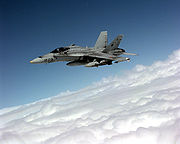
[edit] Spain
The Spanish Air Force ordered 60 EF-18A/A+ model and 12 B/B+ model Hornets, and also received 24 F/A-18s transferred from U.S. inventory. Six of the Spanish Hornets were lost. The Hornet is designated C.15 by Spain.[11] Delivery of the Spanish version started on November 22, 1985.[8]
[edit] Switzerland
Switzerland's Luftwaffe purchased 26 C models and 8 D models. One D model was lost in a crash.[11] Delivery of the aircraft started on 25 January 1996.[8]
[edit] Potential sales
The F/A-18C and F/A-18D were considered by the French Marine Nationale during the 1980s for deployment on their aircraft carriers Clemenceau and Foch[13] and again in the 1990s for the later nuclear-powered Charles de Gaulle,[14] in the event that the Dassault Rafale M was not brought into service when originally planned.
Austria,[15] Chile,[6] Czech Republic,[15] Hungary,[15] Philippines,[15] Poland,[15] and Singapore[6] evaluated the Hornet but did not purchase it. Thailand ordered four C and four D model Hornets but the Asian financial crisis in the late 1990s resulted in the order being canceled. The U.S. DoD then purchased the in-production Hornets for the Marine Corps.[6]
[edit] Design
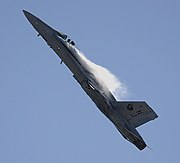
The F/A-18 is a twin engine, mid-wing, multi-mission tactical aircraft. It is superbly maneuverable, owing to its good thrust to weight ratio, digital fly-by-wire control system, and leading edge extensions (LEX). The LEX allow the Hornet to remain controllable at high angles of attack. This is because the LEX produce powerful vortices over the wings, creating turbulent airflow over the wings and thus delaying or eliminating the aerodynamic separation responsible for stall, allowing the Hornet's wings to generate lift several times the aircraft's weight, despite high angles of attack. The Hornet is therefore capable of extremely tight turns over a large range of speeds.
Canted vertical stabilizers are another distinguishing design element, and among the other design characteristics that enable the Hornet's excellent high angle-of-attack capability include oversized horizontal stabilators, oversized trailing edge flaps that operate as flaperons, large full-length leading-edge flaps, and flight control computer programming that multiplies the movement of each control surface at low speeds and moves the vertical rudders inboard instead of simply left and right. The Hornet's normally high angle-of-attack performance envelope was put to rigorous testing and enhanced in the NASA F-18 HARV. NASA used the F-18 High-Alpha Research Vehicle (HARV) to flight-validate high angle-of-attack (alpha) handling qualities that had not been done previously because of the difficulty in performing such tests in a safe and methodical manner. F/A-18 stabilators were also used as canards on NASA's F-15S/MTD.
The Hornet was among the first aircraft to heavily utilize multi-function displays, which at the switch of a button allow the pilot to perform either fighter or attack roles or both. This "force multiplier" capability gives the operational commander more flexibility in employing tactical aircraft in a rapidly changing battle scenario. It was the first Navy aircraft to incorporate a digital multiplex avionics bus, enabling easy upgrades.[1]
The Hornet is also notable for having been designed with maintenance in mind, and as a result has required far less downtime than its counterparts, the F-14 Tomcat and the A-6 Intruder. Its mean time between failure is three times greater than any other Navy strike aircraft, and requires half the maintenance time.[1] For example, whereas replacing the engine on the A-4 Skyhawk required removing the aircraft's tail, the engine on the Hornet is attached at only three points and can be directly removed without excessive disassembly. An experienced maintenance crew can remove and replace an F/A-18 engine in only a couple of hours.
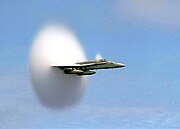
The General Electric F404-GE-400 or F404-GE-402 engines powering the Hornet were also innovative in that they were designed with operability, reliability, and maintainability first. The result is an engine that, while unexceptional on paper in terms of rated performance, demonstrates exceptional robustness under a variety of conditions and is resistant to stall and flameout. By contrast, the Pratt & Whitney TF30 engines that originally powered the F-14A were notoriously prone to flameout under certain flight conditions.
The engine air inlets of the Hornet, like that of the F-16, are "fixed", while those of the F-4, F-14, and F-15 have variable geometry or variable ramp engine air inlets. The variable geometry enables high-speed aircraft to keep the velocity of the air reaching the engine below supersonic. This is one speed limiting factor in the Hornet design. Instead, the Hornet uses bleed air vents on the inboard surface of the engine air intake ducts to slow and reduce the amount of air reaching the engine. While not as effective as variable geometry, the bleed air technique functions well enough to achieve near Mach 2 speeds, which is within the designed mission requirements. The less sophisticated design is also more robust.
Because it was designed as a light multirole aircraft to complement the specialized F-14 and A-6 airframes, it had a relatively low internal fuel fraction. That is, its internal fuel capacity is small relative to its take-off weight, at around 23%. Most aircraft of its class has a fuel fraction between .30 to .35. This situation was exacerbated by the addition of new avionics over its lifespan, further reducing the fuel fraction. This leads to 330-gallon external tanks being a common sight on F-18s, with the centerline and inner wings stations (numbered 3, 5 and 7) being plumbed to transfer fuel.
[edit] Design evolution
In the 1990s the US Navy faced the need to replace its aging A-6 Intruders, EA-6 Prowlers, A-7 Corsair IIs and F-14 Tomcats without proper replacements in development. To answer this deficiency, the Navy had the F/A-18E/F Super Hornet developed. Despite its designation, it is not an upgrade of the F/A-18 Hornet, but rather, a new, larger airframe utilizing the design concepts of the Hornet. Until the deployment of the F-35C Lightning II, Hornets and Super Hornets will serve complementary roles in the US Navy carrier arsenal.
[edit] Operational history
[edit] United States
[edit] Entry into service
McDonnell Douglas rolled out the first F/A-18A on 13 September 1978,[8] in blue-on-white colors marked with "Navy" on the left and "Marines" on the right. Its first flight was on 18 November.[8] In a break with tradition, the Navy pioneered the "principal site concept"[5] with the F/A-18, where almost all testing was done at NAS Pax River,[1] instead of near the site of manufacture, and involving Navy test pilots instead of contractor pilots much earlier in the process.
In March 1979, Lt Cdr John Padgett became the first Navy pilot to fly the F/A-18.[16] In all, nine F/A-18As and two F/A-18Bs were assigned to flight systems development. During this period, the snag on the leading edge of the stabilators was filled in, and the gap between the leading edge root extendors (LERX) and the fuselage mostly filled in. The gap, called the boundary layer air discharge (BLAD) slots, controlled the vortices generated by the LERX and presented clean air to the vertical stabilizers at high angles of attack. However, they also generated a great deal of parasitic drag, worsening the problem of the F/A-18's inadequate range. McDonnell filled in 80% of the gap, leaving a small slot to bleed air from the engine intake. This may have contributed to early problems with fatigue cracks appearing on the vertical stabilizers due to extreme aerodynamic loads, resulting in a momentary grounding in 1984 until the stabilizers were strengthened.[citation needed] Starting in May 1988, a small vertical fence was added to the top of each LEX to broaden the vortices and direct them away from the vertical stabilizers. This also provided a minor increase in controllability as a side effect.

The first production F/A-18A flew on 12 April 1980, and following trials by VX-4 and VX-5, began to fill the Fleet Replacement Squadrons (FRS) VFA-125, VFA-106, and VMFAT-101, where pilots are introduced to the F/A-18. The Hornet entered operational service with Marine Corps squadron VMFA-314 at MCAS El Toro on 7 January 1983,[8] and with Navy squadron VFA-113 in March 1983, replacing F-4s and A-7Es, respectively.[1] The initial fleet reports were complimentary, indicating that the Hornet was extraordinarily reliable, a major change from its predecessor, the F-4J.[6] Other squadrons that switched to F/A-18 are VFA-146 "Blue diamonds", and VFA-147 "Argonauts". In January 1985, the VFA-131 Wildcats moved from Naval Air Station Lemoore to Naval Air Station Cecil Field, Florida, and became the Atlantic Fleet’s first F/A-18 squadron.

The US Navy's Blue Angels aerobatic team switched to the F/A-18 Hornet in 1986,[8] when it replaced the A-4 Skyhawk. The Blue Angels perform in F/A-18A and B models at airshows and other special events across the US and worldwide. Blue Angels pilots must have 1,350 hours and an aircraft carrier certification. The Blue Angels have used the Hornet since The two-seat B model is typically used to give rides to VIPs, but can also fill in for other aircraft in the squadron in a normal show if the need arises.
After a production run of 380 F/A-18As[8] (including the nine assigned to flight systems development), manufacture shifted to the F/A-18C in September 1987.[1] As the A-6 Intruder was retired in the 1990s, its role was filled by the F/A-18. The F/A-18 demonstrated its versatility and reliability during Operation Desert Storm, shooting down enemy fighters and subsequently bombing enemy targets with the same aircraft on the same mission, and breaking all records for tactical aircraft in availability, reliability, and maintainability. The aircraft's survivability was proven by Hornets taking direct hits from surface-to-air missiles, recovering successfully, being repaired quickly, and flying again the next day.
[edit] Combat service
The F/A-18 first saw combat action in April 1986, when VFA-131 Hornets from USS Coral Sea flew SEAD missions against Libyan air defenses during Operation Prairie Fire and an attack on Benghazi as part of Operation El Dorado Canyon.[6]
Two U.S. Navy F/A-18s were destroyed, with the loss of their pilots, during the Gulf War.[6] On 17 January 1991, the first day of the war, Lt Cmdr Scott Speicher (VFA-81) was shot down and remains missing in action. The U.S. Navy maintains that Speicher was downed by a surface to air missile.[17] However, an unclassified summary of a 2001 CIA report states that Speicher's aircraft was shot down by a missile from an Iraqi aircraft, and that he may have survived by ejecting.[18] One source claims that the Iraqi aircraft was a MiG-25, firing a Bisnovat R-40/AA-6 Acrid missile.[19] The other F/A-18 destroyed was piloted by Lt Robert Dwyer, who has been officially listed as killed in action; the cause of his loss is unclear.
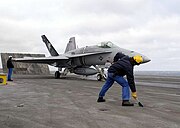
F/A-18 pilots were credited with two kills during the Gulf War, both MiG-21s.[20] On the first day of the war, U.S. Navy pilots Lt Nick Mongilio and Lt Cmdr Mark Fox were sent from the USS Saratoga in the Red Sea to bomb an airfield in southwestern Iraq. While enroute they were warned by E-2 of approaching MiG-21 aircraft. The Hornets shot down two MiGs and resumed their bombing run, each carrying four 2,000 lb bombs, before returning to Saratoga. Mongilio and Fox become the first pilots to register air-to-air kills while still completing their original air-to-ground mission.[8][1] Overall during the Gulf War, F/A-18s flew 4,551 sorties with ten Hornets damaged including the two previously mentioned losses.[6]
Both U.S. Navy F/A-18A/C models and Marine F/A-18A/C/D models were used continuously in Operation Southern Watch and over Bosnia and Kosovo in the 1990s. U.S. Navy Hornets flew in Operation Enduring Freedom from carriers operating in the North Arabian Sea. Both the F/A-18A/C and newer F/A-18E/F variants were used in Operation Iraqi Freedom, operating from aircraft carriers. Later in the conflict USMC A+, C, and primarily D models operated from bases within Iraq. A F/A-18C was accidentally downed in a Friendly Fire incident by a Patriot missile early in the conflict, and two others collided over Iraq in May 2005.
[edit] Non-US service
In 2001, Australia deployed four aircraft to Diego Garcia, in an air defence role, during coalition operations against the Taliban in Afghanistan. In 2003, 75 Squadron operated 14 F/A-18s as part of Operation Falconer.
[edit] Variants
[edit] A/B
The F/A-18A is the single-seat variant and the F/A-18B is the two seat variant. The space for the two seat cockpit is provided by a relocation of avionic equipment and a 6% reduction in internal fuel; two-seat Hornets are otherwise fully combat-capable. The B model is used primarily for training.
In 1992, the original Hughes AN/APG-65 radar was replaced with the Hughes (now Raytheon) AN/APG-73, a faster and more capable radar. The A model Hornets upgraded to the AN/APG-73 are designated F/A-18A+.
[edit] C/D
The F/A-18C is the single-seat variant and the F/A-18D is the two seat variant. The D model can be configured for training or as an all-weather strike craft. The "missionized" D's rear seat is configured for a Weapons and Sensors Officer to assist in operating the weapons systems. The D model is primarily operated by the U.S. Marine Corps in the night attack and FAC(A) (Forward Air Controller (Airborne)) roles.
The F/A-18C and D models are the result of a block upgrade in 1987[8] incorporating upgraded radar, avionics, and the capacity to carry new missiles such as the AIM-120 AMRAAM air-to-air missile and AGM-65 Maverick[1] and AGM-84 Harpoon air-to-surface missiles. Other upgrades include the Martin-Baker NACES (Navy Aircrew Common Ejection Seat), and a self-protection jammer. A synthetic aperture ground mapping radar enables the pilot to locate targets in poor visibility conditions. C and D models delivered since 1989 also include an improved night attack capability, consisting of the Hughes AN/AAR-50 thermal navigation pod, the Loral AN/AAS-38 Night Hawk FLIR (forward looking infrared array) targeting pod, night vision goggles, and two full-color (previously monochrome) MFDs and a color moving map.[1]
In addition, 48 D model Hornets are configured for reconnaissance as the F/A-18D (RC) version, substituting the gun with an electro-optical sensor package called ATARS.
Beginning in 1991, Hornets were upgraded to the F404-GE-402 engine, providing a 20% increase in thrust. Since 1993, the AN/AAS-38 Nite Hawk also has a designator/ranger laser, allowing it to self-mark targets.
Production of the F/A-18C ended in 1999. In 2000, the last F/A-18D was delivered to the U.S. Marine Corps.[8]
[edit] E/F Super Hornet

The single seat F/A-18E and two-seat F/A-18F Super Hornets carry over the name and design concept of the original F/A-18, but have been extensively redesigned. The Super Hornet has a new, 25% larger airframe, larger air intakes, more powerful GE F414 engines based on F/A-18's F404, and upgraded avionics suite. The aircraft is currently in production and will eventually equip 22 squadrons.
[edit] EA-18G Growler
The EA-18G Growler is an electronic warfare version of the F/A-18F Super Hornet, which entered production in 2007. The EA-18G is scheduled to finish flight testing in 2008, then earn initial operational capability in 2009.[21] The Growler will replace the Navy's EA-6B Prowler.
[edit] Other U.S. variants
- RF-18
- This designation was given to a reconnaissance version of the F/A-18A. The first of two prototypes flew in February 1984, however the variant was not produced.
- TF-18A
- Two-seat training version of the F/A-18A fighter, later redesignated F/A-18B.

- F-18D(CR)
- Proposed two-seat reconnaissance version for the US Marine Corps. The F-18D(CR) was originally intended to replace the RF-4B Phantom II tactical reconnaissance aircraft. None were ever built.
- F-18 HARV
- Single-seat high-alpha research vehicle for NASA.
- X-53 Active Aeroelastic Wing
- A NASA F/A-18 has been modified to demonstrate the Active Aeroelastic Wing technology, and was designated X-53 in December 2006.
[edit] Export variants
These designations are not part of 1962 United States Tri-Service aircraft designation system.
- F-18L
- This was a lighter land-based version of the F/A-18 Hornet. It was designed to be a single-seat air-superiority fighter and ground-attack aircraft. It was originally intended to be assembled by Northrop as the export version of the F/A-18 Hornet. The F-18L was lighter due to the removal of carrier landing capability. Despite the advantages, customers preferred the "ordinary" Hornet, and the F-18L never went into production.[6]
- (A)F/A-18A/B
- (A)F/A-18A: Single-seat fighter/attack version for the Royal Australian Air Force.
- (A)F/A-18B: Two-seat training version for the Royal Australian Air Force.
- "F/A-18A" was the original company designation, designations of "AF-18A" & "ATF-18A" have also been applied. Assembled in Australia (excluding the first two (A)F/A-18Bs) by Aero-Space Technologies of Australia (ASTA) from 1985 through to 1990, from kits produced by McDonnell Douglas with increasing local content in the later aircraft. Originally the most notable differences between an Australian (A)F/A-18A/B and a US F/A-18A/B were the lack of a catapult attachment, replacement of the carrier tailhook for a lighter "land" arresting hook, and the replacement of the automatic carrier landing system with an Instrument Landing System. Australian Hornets have been involved in a number of major upgrade programs. This program called HUG (Hornet Upgrade) has had a few evolutions over the years. The first was to give Australian Hornets F/A-18C model avionics. The second and current upgrade program (HUG 2.2) updates the fleet's avionics even further.
- CF-18A : Single-seat fighter/attack version for the Canadian Forces. The Canadian Forces' official designation is CF-188A Hornet.
- CF-18B : Two-seat training version for the Canadian Forces. The Canadian Forces' official designation is CF-188B Hornet.
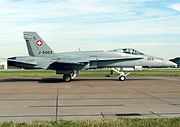
- EF-18 Hornet
- EF-18A: Single-seat fighter/attack version for the Spanish Air Force. The Spanish Air Force designation is C.15.
- EF-18B: Two-seat training version for the Spanish Air Force. The Spanish Air Force designation is CE.15.
- KAF-18 Hornet
- KAF-18C: Single-seat fighter/attack version for the Kuwait Air Force.
- KAF-18D: Two-seat training version for the Kuwait Air Force.
- The Finnish Air Force uses F/A-18C/D Hornets, with a Finland-specific mid-life update. The 57 single-seated F-18C model units were assembled by Patria in Finland.[22]
- F-18C/D Hornet
- Switzerland uses F-18C/D,[23] later Swiss specific mid-life update. The Swiss F-18s were originally without ground attack capability until hardware was retrofitted.
[edit] Operators
[edit] Specifications (F/A-18C/D)
Data from U.S. Navy fact file,[24] Aerospaceweb[25]
General characteristics
- Crew: F/A-18C: 1, F/A-18D: 2 (pilot and weapons system officer)
- Length: 56 ft (17.1 m)
- Wingspan: 40 ft (12.3 m)
- Height: 15 ft 4 in (4.7 m)
- Wing area: 400 ft² (38 m²)
- Airfoil: NACA 65A005 mod root, 65A003.5 mod tip
- Empty weight: 24,700 lb (11,200 kg)
- Loaded weight: 37,150 lb (16,850 kg)
- Max takeoff weight: 51,550 lb (23,400 kg)
- Powerplant: 2× General Electric F404-GE-402 turbofans
- Dry thrust: 11,000 lbf (48.9 kN) each
- Thrust with afterburner: 17,750 lbf (79.2 kN) each
Performance
- Maximum speed: Mach 1.8 (1,190 mph, 1,915 km/h) at 40,000 ft (12,190 m)
- Combat radius: 330 mi (290 NM, 537 km) on hi-lo-lo-hi mission
- Ferry range: 2,070 mi (1,800 NM, 3,330 km) (range without ordnance)
- Service ceiling 50,000 ft (15,000 m)
- Rate of climb: 50,000 ft/min (254 m/s)
- Wing loading: 93 lb/ft² (450 kg/m²)
- Thrust/weight: >0.95
Armament
- Guns: 1x 20 mm M61 Vulcan internal gatling gun with 578 rounds
- Hardpoints: 9: 2 wingtip, 4 underwing, and 3 fuselage, carrying up to 13,700 lb (6,215 kg) of missiles, rockets, bombs, fuel tanks, and pods
- Missiles:
- Air-to-air: AIM-9 Sidewinder, AIM-132 ASRAAM, AIM-120 AMRAAM, AIM-7 Sparrow, IRIS-T
- Air-to-ground: AGM-45 Shrike, AGM-65 Maverick, AGM-88 HARM, SLAM-ER, JSOW, Taurus missile
- Anti-ship: AGM-84 Harpoon
- Bombs: CBU-87 cluster, CBU-89 gator mine, CBU-97 CEM, Paveway, JDAM, Mk 80 series, nuclear bombs,[26] Mk 20 Rockeye II cluster, mines
- Missiles:
Avionics
[edit] Popular culture
Hornets make frequent appearances in action movies and military novels. The Hornet was featured in the film Independence Day.
- Jane's survey sims US Navy Fighters (1994)
- Jane's Fighters Anthology (1997)
- Jane's F/A-18 Simulator
[edit] References
- ^ a b c d e f g h i j k F/A-18 Hornet. Federation of American Scientists. Retrieved on 2007-03-20.
- ^ Kelly, Orr. Hornet: the Inside Story of the F/A-18. Novato, California: Presido Press, 1990. ISBN 0-89141-344-8.
- ^ a b Jenkins 2000, p. 19-21.
- ^ Cite error: Invalid
tag; no text was provided for refs namedJenkins - ^ Crick, Darren. ADF Aircraft Serial Numbers RAAF A21 McDonnell Douglas F/A-18A/B Hornet. Retrieved on 31 December 2006.
- ^ a b c d e f g h i j k l m F/A-18 Hornet Milestones, Boeing, accessed 2007-03-17.
- ^ Nelson, Brendan (2007-02-01). Joint Strike Fighter. Media Release. Defence Ministers & Parliamentary secretary. Retrieved on 2007-03-20.
- ^ Nelson, Brendan (2007-03-06). $6 Billion to maintain Australia's regional air superiority. Media Release. Defence Ministers & Parliamentary secretary. Retrieved on 2007-03-20.
- ^ a b c d Senior, Tim. F/A-18 Hornet, The AirForces Monthly book of, AirForces Monthly, 2003. ISBN 0-946219-69-9.
- ^ Boeing Delivers Malaysian Hornets on Schedule. Boeing (1997-09-09). Retrieved on 2007-03-17.
- ^ Tillman Barrett. MiG Master: Story of the F-8 Crusader (second edition). Annapolis, Maryland: Naval Institute Press, 1990. ISBN 0-87021-585-X.
- ^ Donald, David. Carrier Aviation Air Power Directory. London: AIRtime Publishing Inc, 2001, p. 122. ISBN 1-880588-43-9.
- ^ a b c d e "Philippine Pilots Complete F/A-18 HORNET Flight Evaluation", McDonnell Douglas, December 11, 1996.
- ^ Jenkins 2000, p. 29.
- ^ U.S. Navy Aviation, Ch 12, The First Half of the Nineties, U.S Navy, 1997.
- ^ Intelligence Community Assessment Of The Lieutenant Commander Speicher Case CIA
- ^ acig.org, 2006, "Iraqi Air-to-Air Victories since 1967"
- ^ Miller, David. The Illustrated Directory of Modern Weapons. St. Paul, Minnesota: MBI Publishing Company, 2002. ISBN 0-7603-1346-6.
- ^ "Boeing Delivers First Production EA-18G Growler to U.S. Navy", Boeing, September 25, 2007.
- ^ Karivalo, Perttu: Tomcat vs. Hornet: An Air Forces Monthly Special, page 68. Key Publishing Ltd, 2003.
- ^ Nicholls, Mark: Tomcat vs. Hornet: An Air Forces Monthly Special, page 78. Key Publishing Ltd, 2003.
- ^ F/A-18 US Navy fact file
- ^ F/A-18 Hornet page on Aerospaceweb.org
- ^ Designations of U.S. Nuclear Weapons
- Drendel, Lou. F/A-18 Hornet in action (Aircraft Number 136). Carrollton, Texas: Squadron/Signal Publications, 1993. ISBN 0-89747-300-0.
- Boeing F/A-18C Hornet. Air to Air Combat.com. Access date: 11 May 2005.
- Gunston, Bill. F/A-18 Hornet (Modern Combat Aircraft 22). St. Paul, Minnesota: Motorbooks International, 1985. ISBN 0-710-1485-X.
- Jenkins, Dennis R. F/A-18 Hornet: A Navy Success Story. New York: McGraw-Hill, 2000. ISBN 0-07-134696-1.
- Miller, Jay. McDonnell Douglas F/A-18 Hornet (Aerofax Minigraph 25). Arlington, Texas: Aerofax Inc., 1988. ISBN 0-942548-39-6.
- Peacock, Lindsay. F/A-18 Hornet (Osprey Combat Aircraft Series). London: Osprey Publishing, 1986. ISBN 0-85045-707-6.
- Spick, Mike. McDonnell Douglas F/A-18 Hornet (Classic Warplanes). London, Salamander Books, 1991. ISBN 0-8317-1412-3.
- Vann, Frank. McDonnell Douglas F/A-18 Hornet (How They Work: Jet Fighter). New York: Exeter Books, 1988. ISBN 07917-0226-X.
[edit] See also
Related development
Comparable aircraft
Related lists
- List of active United States military aircraft
- List of fighter aircraft
- List of military aircraft of the United States
[edit] External links
- F/A-18 Hornet U.S. Navy fact file and F/A-18 Hornet Navy history page
- F/A-18 Hornet page and F/A-18E/F Super Hornet page on Boeing.com
- F/A-18 Hornet on GlobalSecurity.org
- F/A-18 Hornet pages on Vectorsite.net
- F/A-18A Hornet page and Flying the F/A-18F Super Hornet page on ausairpower.net
| [show] |
|---|
| [show] |
|---|
| [show] |
|---|
| [show] |
|---|
Categories: All articles with unsourced statements | Articles with unsourced statements since November 2007 | Jet aircraft | Carrier-based aircraft | United States attack aircraft 1970-1979 | United States fighter aircraft 1970-1979 | United States Marine Corps equipment | McDonnell Douglas aircraft











0 Comments:
Post a Comment
Subscribe to Post Comments [Atom]
<< Home